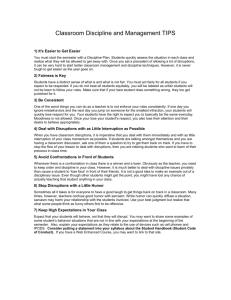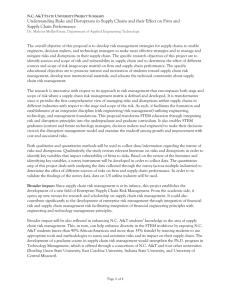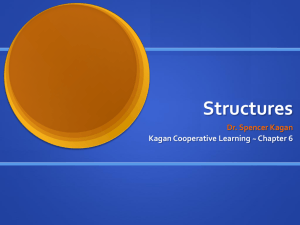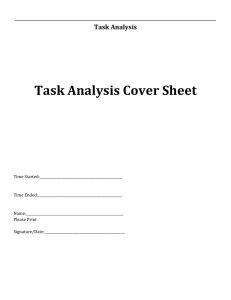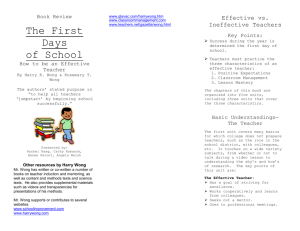Classroom Management Plan
advertisement
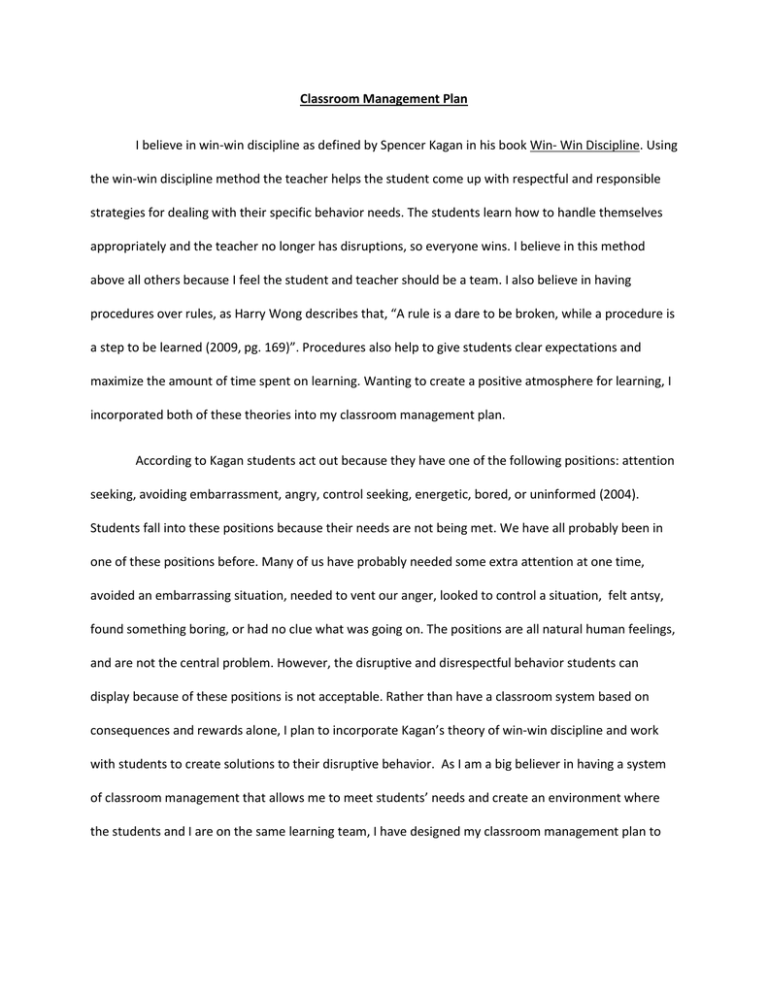
Classroom Management Plan I believe in win-win discipline as defined by Spencer Kagan in his book Win- Win Discipline. Using the win-win discipline method the teacher helps the student come up with respectful and responsible strategies for dealing with their specific behavior needs. The students learn how to handle themselves appropriately and the teacher no longer has disruptions, so everyone wins. I believe in this method above all others because I feel the student and teacher should be a team. I also believe in having procedures over rules, as Harry Wong describes that, “A rule is a dare to be broken, while a procedure is a step to be learned (2009, pg. 169)”. Procedures also help to give students clear expectations and maximize the amount of time spent on learning. Wanting to create a positive atmosphere for learning, I incorporated both of these theories into my classroom management plan. According to Kagan students act out because they have one of the following positions: attention seeking, avoiding embarrassment, angry, control seeking, energetic, bored, or uninformed (2004). Students fall into these positions because their needs are not being met. We have all probably been in one of these positions before. Many of us have probably needed some extra attention at one time, avoided an embarrassing situation, needed to vent our anger, looked to control a situation, felt antsy, found something boring, or had no clue what was going on. The positions are all natural human feelings, and are not the central problem. However, the disruptive and disrespectful behavior students can display because of these positions is not acceptable. Rather than have a classroom system based on consequences and rewards alone, I plan to incorporate Kagan’s theory of win-win discipline and work with students to create solutions to their disruptive behavior. As I am a big believer in having a system of classroom management that allows me to meet students’ needs and create an environment where the students and I are on the same learning team, I have designed my classroom management plan to follow Spencer Kagan’s pillars for win-win discipline: “same-side”, “shared responsibility”, and “learned responsibility” (2004). In my management program students will help to create the classroom agreement. I have created a classroom agreement with only one class rule: respect yourself and others. As Harry Wong says, “A rule is a dare to be broken (2009, pg. 169)”. So instead of many rules I plan to have many procedures, and only one rule. However respect is a rule that works for almost all types of classroom disruptions. For example Kagan defines four categories for classroom disruptions: aggression, rulebreaking, confrontation, and disengagement (2004). All of these disruptions can be related to a display of lack of respect for ones’ self or others when it really comes down to it. I plan to have a Socratic seminar with my students on the first day of school where we will define how different types of actions can be disrespectful, what respect is, why respect is important, and how this rule is beneficial to the students. I plan to have this rule posted as a banner above the white board in the front of the room. The classroom agreement will state the one class rule (respect), the rewards for following the rule, and consequences for breaking it. I have already designed one reward for the agreement; a homework pass for every month the student is completely respectful. There remains a second blank on the contract where students will brainstorm and vote on the first day of class for a reasonable second reward for always showing respect. Students will also brainstorm and vote on a punishment for students who are disrespectful twice in one week, after being given a second chance. When creating the punishment I will give the students feedback and not allow anything too lenient or too over the top to be included in the final vote. Acts of disrespect will be handled using specific steps. Any major offenses of disrespect that physically or mentally harm another student are not tolerated in my classroom and will be brought to the attention of the principal and the students’ parents. However, when students are disrespectful in a manner that is not physically or mentally harmful, they will be asked to retreat to the couch in the corner and fill out a problem solving sheet on how they could have better handled their actions. Students who are too worked up to clearly reflect on their actions can be asked only to sit in the couch and can fill out the problem solving sheet on the following day. After filling out the worksheet and reflecting on how to change their behavior for the better the student will sign and date the sheet agreeing to move forward and act better in the future, and then conference with the teacher about their solutions on the problem solving sheet. Then I will place the work sheet in the day 1 folder on the second chance scale in my room. The second chance scale will be a continuum of folders on the wall marked days 1-5 and a sixth folder marked “Great Turn Around”, every day a student continues to act with respect their worksheet will stay on the second chance scale and will move down one of the five folders on the chart. At the end of each day I will move worksheets down one folder on the continuum. When a worksheet reaches day five, the student may remove their worksheet at the end of the period and place it in the paper shredder. If the student does not remember to remove their worksheet at the end of the period it will be waiting for them and the shredder the next day in the “Great Turn Around” folder. Students who prove themselves and act respectfully during their second chance will not have to serve the class designed punishment for acting disrespectful twice in one week. However they will not be eligible for that months homework pass. If a student continues to act disrespectfully their worksheet will be removed from the second chance scale and they will be filling out the back of the sheet, which is a letter home that explains how they have been disrespectful. Students who have been disrespectful twice in one week will also serve a punishment that will be created and voted on by the class on the first day of school. I believe by involving students in the class agreement, giving students second chances, and helping them to develop solutions before giving them a punishment incorporates all three of Kagan’s pillars for win-win discipline. The students will feel we are on the same side because they helped to design the agreement and feel like a team striving to provide an environment where we can all be treated with respect. I will also stress to students that we all make mistakes and deserve a second chance, as long as no one was seriously hurt. I will explain that instead of jumping right away to punishments in my class, the student will develop strategies on how they could have better handled the situation, the student will conference with the teacher about their problem solving, and then be given a second chance to move forward and act with respect. This will show students that I am on their side and help to create shared and learned responsibility. Students will see I am on their side, because I give them chances to improve before handing out punishments; I would rather see them improve then be punished. Shared responsibility is created by giving the students a problem solving work sheet as a format to reflect on their actions, and I will also help students reflect on ways to improve their actions in a one-one student-teacher conference. Learned responsibility is also promoted as students problem solve ways to act better in the future and practice turning their behavior around by being given second chances. I plan to keep a log of students who fill out problem solving sheets and those who end up sending letters home. If a student has to send home three letters or is filling out problem solving sheets on an almost weekly basis, I will begin taking an inventory of that student’s disruptions. Kagan says there are four ABCD disruptions: aggression (A), rule-breaking (B), confrontation (C), and disengagement (D) (2004). For each disruption type of ABCD disruption he suggests specific preventative strategies. If I find myself observing a student displaying frequent behavior disruptions, I will try to prevent these behaviors by researching and building in preventative strategies to my management plan using Win-Win Discipline as a guide. Since I will be using the preventative strategies from Win-Win Discipline I will keep track of the students disruptive behavior using a behavior chart where I can make checks in columns for A, B, C, and D disruptions. Once I figure out which category of disruption the student falls into the most, I can then begin implementing preventative strategies for that type of disruption. I also plan to prevent classroom disruptions on a whole by having many very clearly defined procedures for the classroom. According to Wong a procedure is a method for getting something done in the classroom and helps a teacher prevent behavior issues, as students readily accept the idea of procedures, because it simplifies the teacher’s expectations. Procedures are also not related to reward and consequence and not viewed by the students as a “dare to be broken (Wong, 2009, pg. 169)”.When students have clear expectations through procedures more time can be spent on academic learning and less time is spent on discipline. I believe the design of my management plan will be beneficial to the students as it does not pose me against them. Instead the students and I work as a team to try and move their behavior forward. Everyone is given a second chance, but the second chance has to be earned by a behavior turn around. My behavior plan is structured in a way that helps students to identify more positive ways to responded instead of acting out and will help students to learn responsibility over time. By reflecting on their negative behaviors and following up with teacher-student conferences on their behavior reflections, students will learn to act appropriately and disruptions should become minimal. My management plan also includes the implementation of many procedures to help minimize student confusion of expectations. This plan will help me and my students create an environment of respect and structure. But most importantly it will help create an environment where learning can occur. References Kagan, S., Kyle, P., & Scott, S. (2004). Win-Win Discipline: Strategies for all Discipline Problems. San Clemente: Kagan Publishing. Wong, H. & Wong, T. (2009). The First Days of School: How to be an Effective Teacher. Mountain View, CA: Harry K. Wong Pulications.

